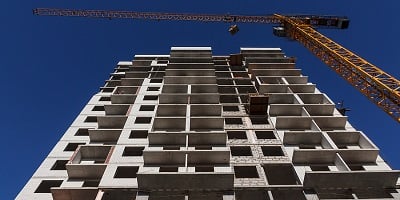What does it take to build a skyscraper? There are so many facets to it. These are projects that cost hundreds of millions of dollars, so naturally, it starts with a planning phase that can take years to get everything right. Then comes the building phase, in which there are several distinct phases. Throughout, contractors rely on a variety of different materials—and of course, heavy duty tools and fasteners such as those offered by ET&F®, a BECK brand.
Let’s take a quick look at the construction phases involved during the build process so that you can better understand how a high rise goes from blueprints to reality.
1. Building a Foundation
Every building needs a foundation, right? In homebuilding, this will either be the structural walls that form the basement, or a slab foundation, which gives builders a flat, stable base to start with.
Skyscrapers do it differently. Here, the “basement” is referred to as the substructure, and it consists of a gigantic pit where builders will use concrete and vertical beams to create underground levels to support the above-ground structure. The substructure’s depth can vary depending on factors like the building’s planned height and the geology of the area. This means digging down to the local bedrock to get the most solid footing possible—and doing that can mean digging several stories deep.
2. Next Comes the Superstructure
When the substructure is completed, the building of the superstructure begins. Think of it like the skyscraper’s skeleton. This portion is above ground and usually constructed of steel. The substructure is designed not only to support the building, but to keep it stable against high winds, earthquakes, and—of course—gravity. The taller a building is, the more work the superstructure needs to create a durable building core.
3. Adding the Exterior
If you’ve ever watched the phases of high-rise construction, this is the phase where the skyscraper starts to look more like a skyscraper and less like an enormous scaffold. During this part of the process, contractors add the façade. Glass, stone, steel, and concrete are just some of the materials used on the exterior. It really depends on the vision for the building, and of course, whatever is trending at the time. Historic skyscrapers often feature beautiful stone exteriors because it was popular, for example, while modern trends skew heavily towards glass exteriors. Concrete is also a widely used material, with 69.2% of high rises in 2019 made largely of concrete.
4. The Finish Work
To an outside observer, this is the portion of the build phase that is least interesting because on the outside, not much changes. Inside, however, there is so much work happening. Whether the skyscraper is intended as office space, apartments or condos, contractors move indoors to start building out facilities. Electrical, HVAC, and plumbing systems go together while contractors install walls, floors, ceilings, and all the essentials on every single floor.
Doing Highrise Work? Invest in the Right Tools and Fasteners
There are millions of tasks that go into skyscraper construction—and many of them require heavy duty tools plus fasteners designed for use with steel, concrete, and other materials commonly used in high rise construction. ET&F® Fastening Systems specialize in fastening solutions for both steel and concrete construction—and that makes their fasteners and pneumatic tools perfect for the job
.svg.png)


